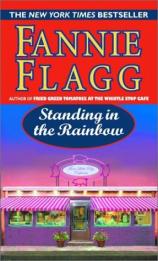Standing in the Rainbow
Review
Standing in the Rainbow
Just
as John Irving excels at portraits of quirky New Englanders, Fannie
Flagg has cornered the market on zany midwestern folks.
Resurrecting the lovable, laughable characters from her previous
novel WELCOME TO THE WORLD, BABY GIRL, Flagg's latest effort
STANDING IN THE RAINBOW is combination comic genius and tribute to
the past.
The town itself --- Elmwood Springs, Missouri --- is the leading
character here, but it's the supporting roles that drive the story.
From 1946 to 2000, the town is the quaint setting for the everyday
life of radio personality Neighbor Dorothy Smith and her
family.
There's Mother Smith, whose organ music accompanies all of
Dorothy's shows; her husband Doc, the town pharmacist, who knows
all about what ails the residents of Elmwood Springs; teenager
Anna, hormones-a-raging and embarrassment prone; and delightful
Bobby, whose antics are fodder for his mother's show. The Smith
family IS heartland America ---- they are Ozzie and Harriet,
Leave it to Beaver, and Father Knows Best all rolled
up into one.
Beautician Tot Whooten, whose dubious skills are legendary,
introduces the book and recommends "it without any qualms
whatsoever." She's not heard from much as the story evolves, but
her moments on the page are memorable for both their humor and
their universal elements of tragedy. Betty Raye is the singer who
could not sing. Hamm Sparks, loved by two women, is a charmer and a
bornpolitician. Norma and Mackey Warren, town staples, care for
their 98-year-old aunt. Flagg's characters are all-too-human.rich,
warm, funny, everyday folk. Often the characters appear too
briefly, and we want to hear more about them, but I'm grateful for
the brief introduction we did get.
But back to the leading character --- the town. It's evolution is
something to watch. Post World War II, it is a spot on the map full
of optimism and hope, a town reminiscent of all the small towns in
America that boasted a rocking chair by a fireplace in every home.
Everyday drama --- like who won the pie contest at the local fair
or who got a new dog --- was the big news in the beauty salons and
pharmacies across the country. People were settling back into the
comfort they'd known before the war, despite the horrific losses
suffered by many a family, and they were focusing on the good at
hand, the small things to be grateful for, the matters of personal
(not national) import.
In Rainbow, the town changes, at pace with sister hamlets, and yet
something of its charm always remains. As an example, in the '70s,
Neighbor Dorothy's show is still on the air featuring bits such as
"The Superior Way to Crack Hickory Nuts," while other stations are
"blaring rock and roll." Strip malls and uber-stores impose upon
the town, but never truly overtake it.
As Flagg shows us a changing (and often threatening) America, she
reminds us that those elements of an earlier life that were the
backbone of existence remain so --- love and family.
The friendly beautician whose letter of introduction endorses
Rainbow at the outset of the book writes, "I like a book with a
beginning, a middle and an end, and hopefully a plot and a few
laughs in between." Simple demands for a simple town. And Flagg
delivers on all counts, and then some.
Reviewed by Roberta O'Hara on January 23, 2011
Standing in the Rainbow
- Publication Date: June 3, 2003
- Genres: Fiction
- Mass Market Paperback: 544 pages
- Publisher: Ballantine Books
- ISBN-10: 080411935X
- ISBN-13: 9780804119351





